Target Information
| Target General Information | Top | |||||
|---|---|---|---|---|---|---|
| Target ID |
T92640
(Former ID: TTDR00580)
|
|||||
| Target Name |
Lysophosphatidic acid receptor 1 (LPAR1)
|
|||||
| Synonyms |
Lysophosphatidic acid receptor Edg-2; LPA1; LPA-1; LPA receptor 1; EDG2; EDG 2 receptor
Click to Show/Hide
|
|||||
| Gene Name |
LPAR1
|
|||||
| Target Type |
Clinical trial target
|
[1] | ||||
| Disease | [+] 4 Target-related Diseases | + | ||||
| 1 | Fibrosis [ICD-11: GA14-GC01] | |||||
| 2 | Idiopathic interstitial pneumonitis [ICD-11: CB03] | |||||
| 3 | Systemic sclerosis [ICD-11: 4A42] | |||||
| 4 | Psoriasis [ICD-11: EA90] | |||||
| Function |
Plays a role in the reorganization of the actin cytoskeleton, cell migration, differentiation and proliferation, and thereby contributes to the responses to tissue damage and infectious agents. Activates downstream signaling cascades via the G(i)/G(o), G(12)/G(13), and G(q) families of heteromeric G proteins. Signaling inhibits adenylyl cyclase activity and decreases cellular cAMP levels. Signaling triggers an increase of cytoplasmic Ca(2+) levels. Activates RALA; this leads to the activation of phospholipase C (PLC) and the formation of inositol 1,4,5-trisphosphate. Signaling mediates activation of down-stream MAP kinases. Contributes to the regulation of cell shape. Promotes Rho-dependent reorganization of the actin cytoskeleton in neuronal cells and neurite retraction. Promotes the activation of Rho and the formation of actin stress fibers. Promotes formation of lamellipodia at the leading edge of migrating cells via activation of RAC1. Through its function as lysophosphatidic acid receptor, plays a role in chemotaxis and cell migration, including responses to injury and wounding. Plays a role in triggering inflammation in response to bacterial lipopolysaccharide (LPS) via its interaction with CD14. Promotes cell proliferation in response to lysophosphatidic acid. Required for normal skeleton development. May play a role in osteoblast differentiation. Required for normal brain development. Required for normal proliferation, survival and maturation of newly formed neurons in the adult dentate gyrus. Plays a role in pain perception and in the initiation of neuropathic pain. Receptor for lysophosphatidic acid (LPA).
Click to Show/Hide
|
|||||
| BioChemical Class |
GPCR rhodopsin
|
|||||
| UniProt ID | ||||||
| Sequence |
MAAISTSIPVISQPQFTAMNEPQCFYNESIAFFYNRSGKHLATEWNTVSKLVMGLGITVC
IFIMLANLLVMVAIYVNRRFHFPIYYLMANLAAADFFAGLAYFYLMFNTGPNTRRLTVST WLLRQGLIDTSLTASVANLLAIAIERHITVFRMQLHTRMSNRRVVVVIVVIWTMAIVMGA IPSVGWNCICDIENCSNMAPLYSDSYLVFWAIFNLVTFVVMVVLYAHIFGYVRQRTMRMS RHSSGPRRNRDTMMSLLKTVVIVLGAFIICWTPGLVLLLLDVCCPQCDVLAYEKFFLLLA EFNSAMNPIIYSYRDKEMSATFRQILCCQRSENPTGPTEGSDRSASSLNHTILAGVHSND HSVV Click to Show/Hide
|
|||||
| 3D Structure | Click to Show 3D Structure of This Target | AlphaFold | ||||
| Drugs and Modes of Action | Top | |||||
|---|---|---|---|---|---|---|
| Clinical Trial Drug(s) | [+] 4 Clinical Trial Drugs | + | ||||
| 1 | BMS-986020 | Drug Info | Phase 2 | Scleroderma | [2] | |
| 2 | BMS-986278 | Drug Info | Phase 2 | Pulmonary fibrosis | [3] | |
| 3 | SAR-100842 | Drug Info | Phase 2 | Fibrosis | [4] | |
| 4 | BMS-986337 | Drug Info | Phase 1 | Pulmonary fibrosis | [5] | |
| Preclinical Drug(s) | [+] 1 Preclinical Drugs | + | ||||
| 1 | BMS-986202 | Drug Info | Preclinical | Idiopathic pulmonary fibrosis | [6], [7] | |
| Mode of Action | [+] 4 Modes of Action | + | ||||
| Antagonist | [+] 14 Antagonist drugs | + | ||||
| 1 | BMS-986020 | Drug Info | [8] | |||
| 2 | BMS-986278 | Drug Info | [9] | |||
| 3 | BMS-986337 | Drug Info | [5] | |||
| 4 | BMS-986202 | Drug Info | [10] | |||
| 5 | anti-BrP-LPA | Drug Info | [14] | |||
| 6 | BrP-LPA | Drug Info | [14] | |||
| 7 | dioctanoylglycerol pyrophosphate | Drug Info | [15] | |||
| 8 | Ki16425 | Drug Info | [16] | |||
| 9 | ONO-3080573 | Drug Info | [20] | |||
| 10 | ONO-9780307 | Drug Info | [20] | |||
| 11 | ONO-9910539 | Drug Info | [20] | |||
| 12 | syn-BrP-LPA | Drug Info | [14] | |||
| 13 | VPC12249 | Drug Info | [21] | |||
| 14 | VPC32183 | Drug Info | [22] | |||
| Modulator | [+] 1 Modulator drugs | + | ||||
| 1 | SAR-100842 | Drug Info | [1] | |||
| Inhibitor | [+] 16 Inhibitor drugs | + | ||||
| 1 | (1,1-Difluoro-pentadecyl)-phosphonic acid | Drug Info | [11] | |||
| 2 | Decyl-phosphonic acid | Drug Info | [11] | |||
| 3 | Dodecyl-phosphonic acid | Drug Info | [11] | |||
| 4 | dodecyl-thiophosphate | Drug Info | [11] | |||
| 5 | Phosphoric acid mono-((E)-dec-4-enyl) ester | Drug Info | [11] | |||
| 6 | Phosphoric acid mono-((E)-dodec-9-enyl) ester | Drug Info | [11] | |||
| 7 | Phosphoric acid mono-((E)-tetradec-11-enyl) ester | Drug Info | [11] | |||
| 8 | Phosphoric acid mono-((E)-tetradec-9-enyl) ester | Drug Info | [11] | |||
| 9 | Phosphoric acid monodec-9-enyl ester | Drug Info | [11] | |||
| 10 | Phosphoric acid monododecyl ester | Drug Info | [11] | |||
| 11 | Phosphoric acid monotetradecyl ester | Drug Info | [11] | |||
| 12 | Tetradecyl-phosphonic acid | Drug Info | [11] | |||
| 13 | Thiophosphoric acid (E)-dodec-9-enyl ester | Drug Info | [11] | |||
| 14 | Thiophosphoric acid (E)-tetradec-9-enyl ester | Drug Info | [11] | |||
| 15 | Thiophosphoric acid dec-9-enyl ester | Drug Info | [11] | |||
| 16 | Thiophosphoric acid decyl ester | Drug Info | [11] | |||
| Agonist | [+] 6 Agonist drugs | + | ||||
| 1 | 2-oleoyl-LPA | Drug Info | [12] | |||
| 2 | alkyl OMPT | Drug Info | [13] | |||
| 3 | LPA | Drug Info | [17] | |||
| 4 | NAEPA | Drug Info | [18] | |||
| 5 | oleoyl-thiophosphate | Drug Info | [19] | |||
| 6 | T13 | Drug Info | [19] | |||
| Cell-based Target Expression Variations | Top | |||||
|---|---|---|---|---|---|---|
| Cell-based Target Expression Variations | ||||||
| Drug Binding Sites of Target | Top | |||||
|---|---|---|---|---|---|---|
| Ligand Name: (2r)-2-Hydroxy-3-(Phosphonooxy)propyl (9e)-Octadec-9-Enoate | Ligand Info | |||||
| Structure Description | Lysophosphatidic acid receptor 1-Gi complex bound to LPA | PDB:7TD0 | ||||
| Method | Electron microscopy | Resolution | 2.83 Å | Mutation | Yes | [23] |
| PDB Sequence |
QCFYNESIAF
32 FYNRSGKHLA42 TEWNTVSKLV52 MGLGITVCIF62 IMLANLLVMV72 AIYVNRRFHF 82 PIYYLMANLA92 AADFFAGLAY102 FYLMFNTGPN112 TRRLTVSTWL122 LRQGLIDTSL 132 TASVANLLAI142 AIERHITVFR152 MQLHTRMSNR162 RVVVVIVVIW172 TMAIVMGAIP 182 SVGWNCICDI192 ENCSNMAPLY202 SDSYLVFWAI212 FNLVTFVVMV222 VLYAHIFGYV 232 RQRTMRMDTM253 MSLLKTVVIV263 LGAFIICWTP273 GLVLLLLDVC283 CPQCDVLAYE 293 KFFLLLAEFN303 SAMNPIIYSY313 RDKEMSATFR323
|
|||||
|
|
TYR34
2.408
LYS39
2.475
HIS40
4.613
TYR102
4.756
LEU105
2.490
THR109
2.379
GLY110
2.634
THR113
2.182
TRP121
4.720
ARG124
2.503
GLN125
2.059
ILE128
2.557
ASP129
2.796
LEU132
2.217
THR133
4.597
SER196
4.207
MET198
2.331
|
|||||
| Click to View More Binding Site Information of This Target and Ligand Pair | ||||||
| Ligand Name: [(2~{R})-2-[5-(2-hexylphenyl)pentanoylamino]-3-oxidanyl-propyl] dihydrogen phosphate | Ligand Info | |||||
| Structure Description | Human Lysophosphatidic Acid Receptor 1-Gi complex bound to ONO-0740556 | PDB:7YU3 | ||||
| Method | Electron microscopy | Resolution | 3.50 Å | Mutation | No | [24] |
| PDB Sequence |
QCFYNESIAF
32 FYNRSGKHLA42 TEWNTVSKLV52 MGLGITVCIF62 IMLANLLVMV72 AIYVNRRFHF 82 PIYYLMANLA92 AADFFAGLAY102 FYLMFNTGPN112 TRRLTVSTWL122 LRQGLIDTSL 132 TASVANLLAI142 AIERHITVFR152 MQLHTRMSNR162 RVVVVIVVIW172 TMAIVMGAIP 182 SVGWNCICDI192 ENCSNMAPLY202 SDSYLVFWAI212 FNLVTFVVMV222 VLYAHIFGYV 232 RQRTMRMDTM253 MSLLKTVVIV263 LGAFIICWTP273 GLVLLLLDVC283 CPQCDVLAYE 293 KFFLLLAEFN303 SAMNPIIYSY313 RDKEMSATFR323
|
|||||
|
|
TYR34
3.171
LYS39
2.642
LEU105
3.617
ASN108
4.207
THR109
3.366
GLY110
4.196
THR113
3.967
ARG124
2.503
GLN125
3.258
ILE128
4.876
ASP129
3.038
LEU132
4.789
MET198
4.696
ALA199
4.033
|
|||||
| Click to View More Binding Site Information of This Target and Ligand Pair | ||||||
| Click to View More Binding Site Information of This Target with Different Ligands | ||||||
| Different Human System Profiles of Target | Top |
|---|---|
|
Human Similarity Proteins
of target is determined by comparing the sequence similarity of all human proteins with the target based on BLAST. The similarity proteins for a target are defined as the proteins with E-value < 0.005 and outside the protein families of the target.
A target that has fewer human similarity proteins outside its family is commonly regarded to possess a greater capacity to avoid undesired interactions and thus increase the possibility of finding successful drugs
(Brief Bioinform, 21: 649-662, 2020).
Human Tissue Distribution
of target is determined from a proteomics study that quantified more than 12,000 genes across 32 normal human tissues. Tissue Specificity (TS) score was used to define the enrichment of target across tissues.
The distribution of targets among different tissues or organs need to be taken into consideration when assessing the target druggability, as it is generally accepted that the wider the target distribution, the greater the concern over potential adverse effects
(Nat Rev Drug Discov, 20: 64-81, 2021).
Human Pathway Affiliation
of target is determined by the life-essential pathways provided on KEGG database. The target-affiliated pathways were defined based on the following two criteria (a) the pathways of the studied target should be life-essential for both healthy individuals and patients, and (b) the studied target should occupy an upstream position in the pathways and therefore had the ability to regulate biological function.
Targets involved in a fewer pathways have greater likelihood to be successfully developed, while those associated with more human pathways increase the chance of undesirable interferences with other human processes
(Pharmacol Rev, 58: 259-279, 2006).
Biological Network Descriptors
of target is determined based on a human protein-protein interactions (PPI) network consisting of 9,309 proteins and 52,713 PPIs, which were with a high confidence score of ≥ 0.95 collected from STRING database.
The network properties of targets based on protein-protein interactions (PPIs) have been widely adopted for the assessment of target’s druggability. Proteins with high node degree tend to have a high impact on network function through multiple interactions, while proteins with high betweenness centrality are regarded to be central for communication in interaction networks and regulate the flow of signaling information
(Front Pharmacol, 9, 1245, 2018;
Curr Opin Struct Biol. 44:134-142, 2017).
Human Similarity Proteins
Human Tissue Distribution
Human Pathway Affiliation
Biological Network Descriptors
|
|
|
Note:
If a protein has TS (tissue specficity) scores at least in one tissue >= 2.5, this protein is called tissue-enriched (including tissue-enriched-but-not-specific and tissue-specific). In the plots, the vertical lines are at thresholds 2.5 and 4.
|
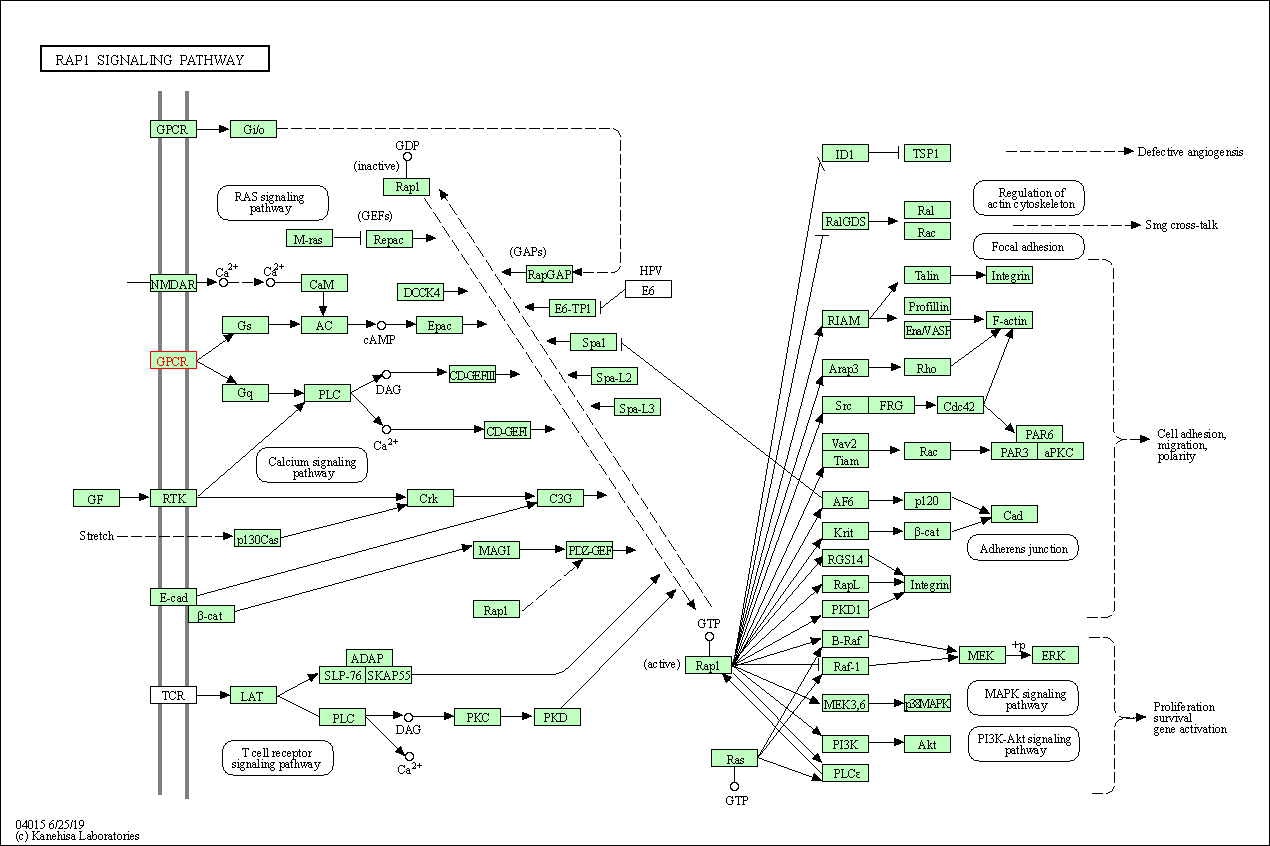

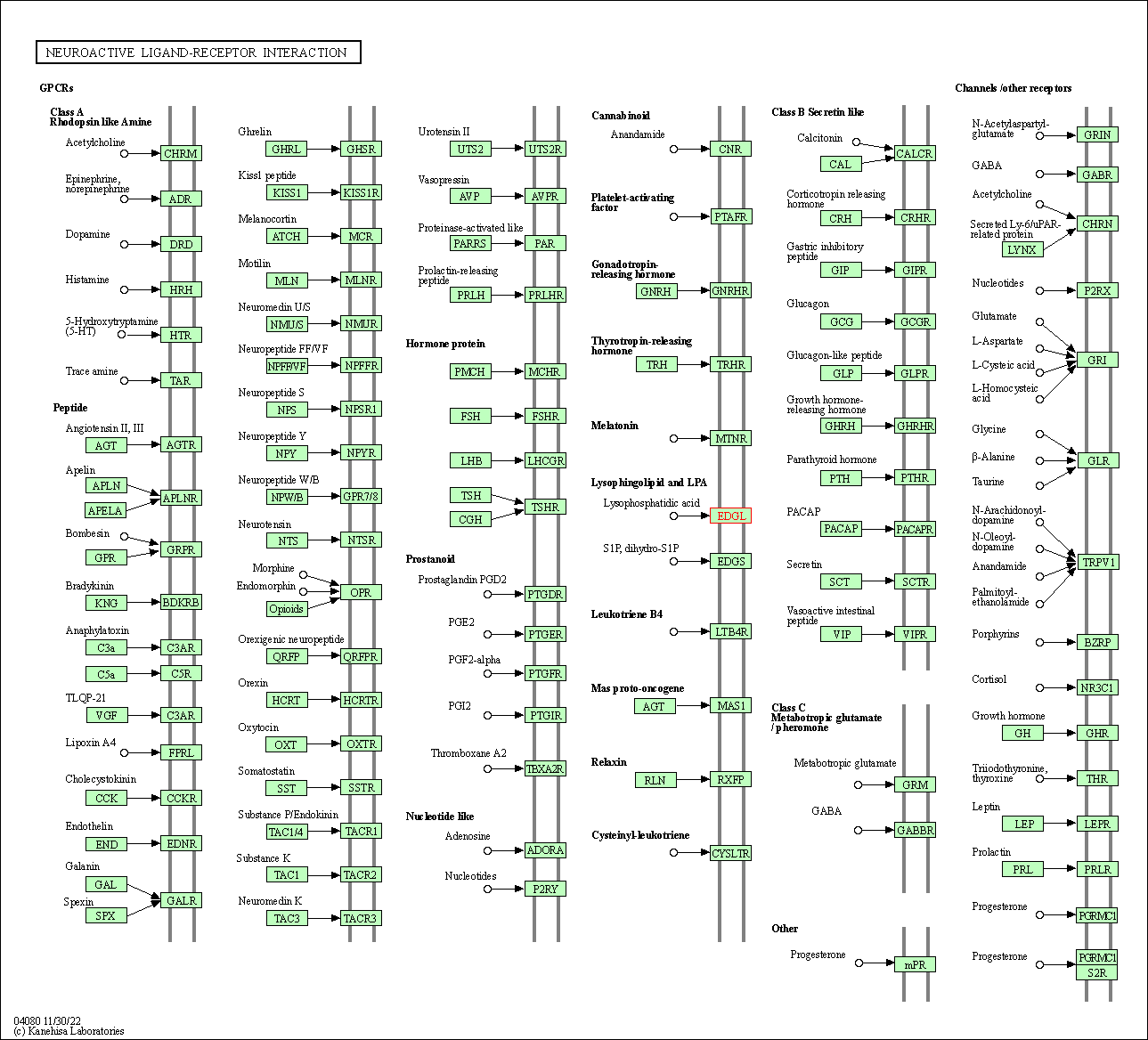
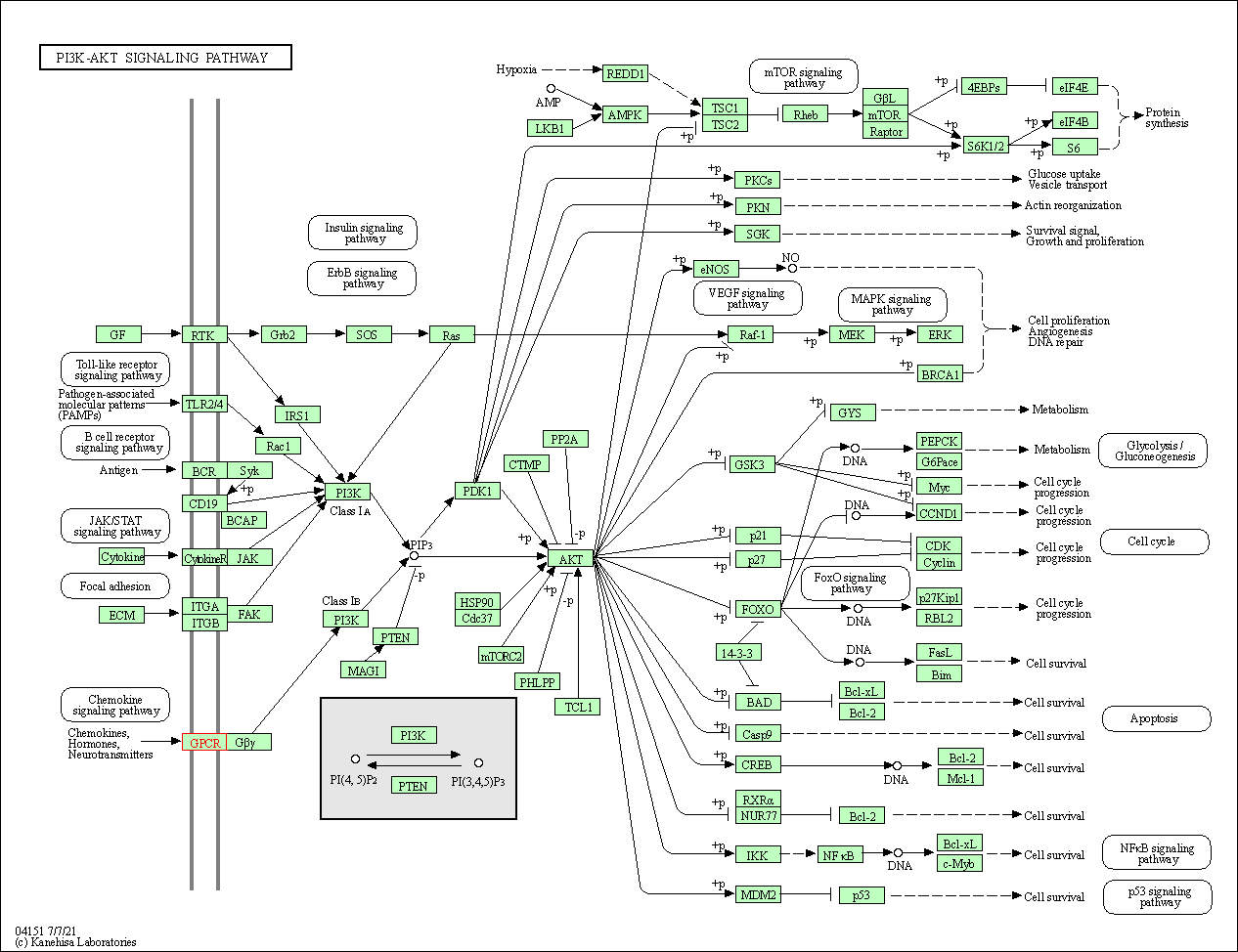
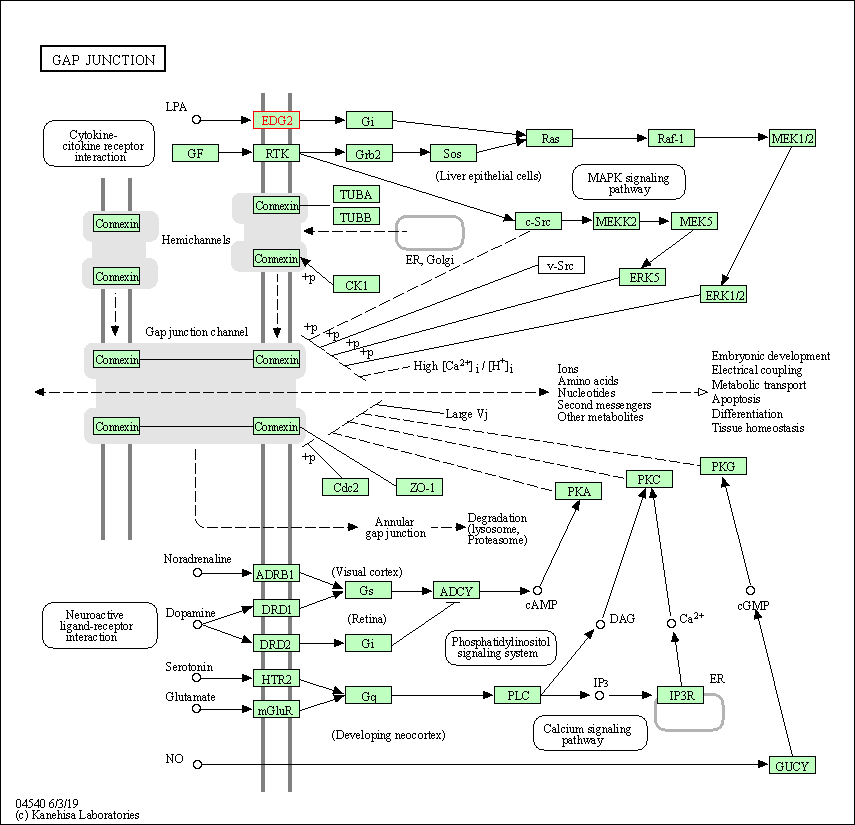
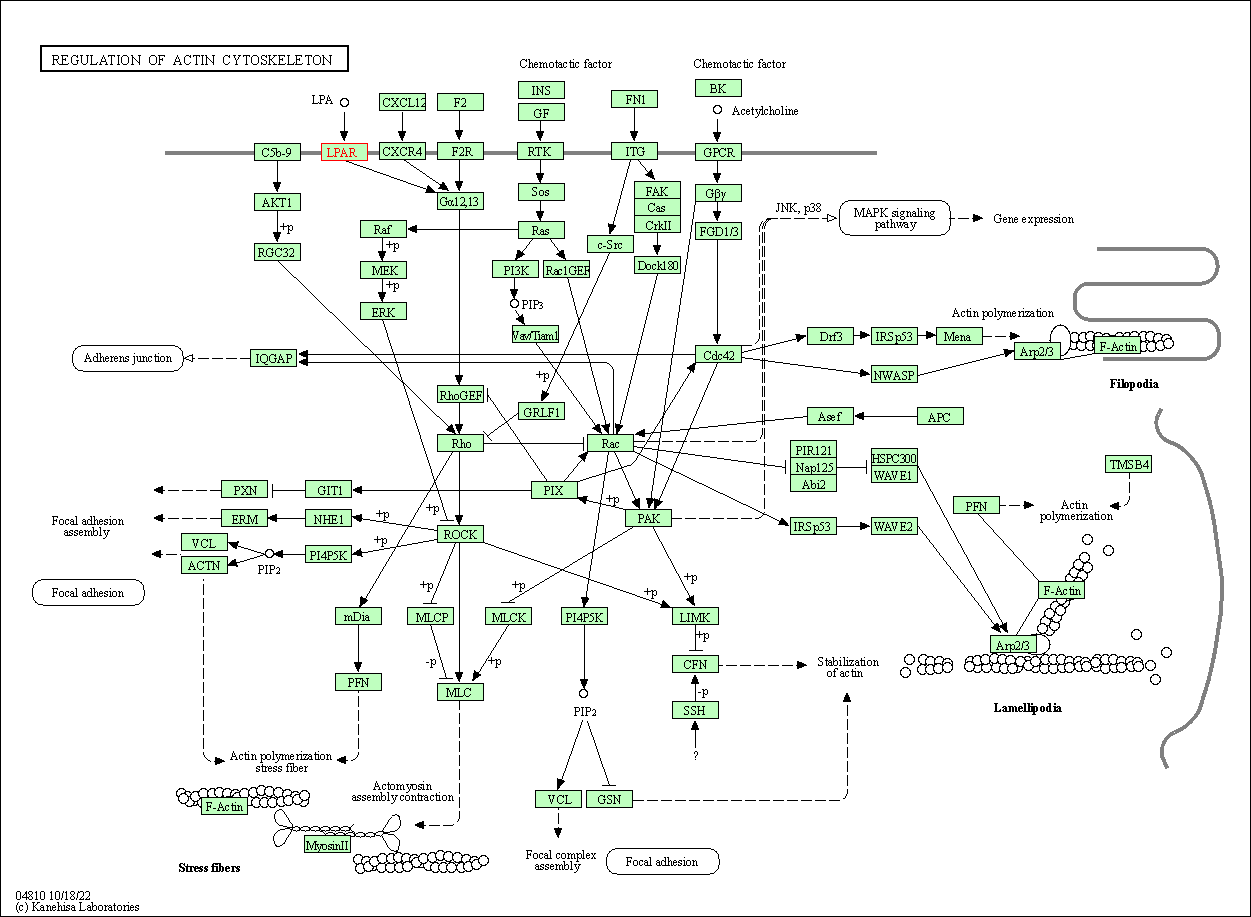
| KEGG Pathway | Pathway ID | Affiliated Target | Pathway Map |
|---|---|---|---|
| Rap1 signaling pathway | hsa04015 | Affiliated Target |

|
| Class: Environmental Information Processing => Signal transduction | Pathway Hierarchy | ||
| Phospholipase D signaling pathway | hsa04072 | Affiliated Target |

|
| Class: Environmental Information Processing => Signal transduction | Pathway Hierarchy | ||
| Neuroactive ligand-receptor interaction | hsa04080 | Affiliated Target |

|
| Class: Environmental Information Processing => Signaling molecules and interaction | Pathway Hierarchy | ||
| PI3K-Akt signaling pathway | hsa04151 | Affiliated Target |

|
| Class: Environmental Information Processing => Signal transduction | Pathway Hierarchy | ||
| Gap junction | hsa04540 | Affiliated Target |

|
| Class: Cellular Processes => Cellular community - eukaryotes | Pathway Hierarchy | ||
| Regulation of actin cytoskeleton | hsa04810 | Affiliated Target |

|
| Class: Cellular Processes => Cell motility | Pathway Hierarchy | ||
| Click to Show/Hide the Information of Affiliated Human Pathways | |||
| Degree | 5 | Degree centrality | 5.37E-04 | Betweenness centrality | 2.12E-04 |
|---|---|---|---|---|---|
| Closeness centrality | 1.75E-01 | Radiality | 1.28E+01 | Clustering coefficient | 0.00E+00 |
| Neighborhood connectivity | 4.80E+00 | Topological coefficient | 2.71E-01 | Eccentricity | 13 |
| Download | Click to Download the Full PPI Network of This Target | ||||
| Chemical Structure based Activity Landscape of Target | Top |
|---|---|
| Drug Property Profile of Target | Top | |
|---|---|---|
| (1) Molecular Weight (mw) based Drug Clustering | (2) Octanol/Water Partition Coefficient (xlogp) based Drug Clustering | |
|
|
||
| (3) Hydrogen Bond Donor Count (hbonddonor) based Drug Clustering | (4) Hydrogen Bond Acceptor Count (hbondacc) based Drug Clustering | |
|
|
||
| (5) Rotatable Bond Count (rotbonds) based Drug Clustering | (6) Topological Polar Surface Area (polararea) based Drug Clustering | |
|
|
||
| "RO5" indicates the cutoff set by lipinski's rule of five; "D123AB" colored in GREEN denotes the no violation of any cutoff in lipinski's rule of five; "D123AB" colored in PURPLE refers to the violation of only one cutoff in lipinski's rule of five; "D123AB" colored in BLACK represents the violation of more than one cutoffs in lipinski's rule of five | ||
| Target Poor or Non Binders | Top | |||||
|---|---|---|---|---|---|---|
| Target Poor or Non Binders | ||||||
| Target Regulators | Top | |||||
|---|---|---|---|---|---|---|
| Target-regulating microRNAs | ||||||
| Target Profiles in Patients | Top | |||||
|---|---|---|---|---|---|---|
| Target Expression Profile (TEP) |
||||||
| Target Affiliated Biological Pathways | Top | |||||
|---|---|---|---|---|---|---|
| KEGG Pathway | [+] 5 KEGG Pathways | + | ||||
| 1 | Rap1 signaling pathway | |||||
| 2 | Neuroactive ligand-receptor interaction | |||||
| 3 | PI3K-Akt signaling pathway | |||||
| 4 | Gap junction | |||||
| 5 | Pathways in cancer | |||||
| NetPath Pathway | [+] 1 NetPath Pathways | + | ||||
| 1 | TGF_beta_Receptor Signaling Pathway | |||||
| PID Pathway | [+] 1 PID Pathways | + | ||||
| 1 | LPA receptor mediated events | |||||
| Reactome | [+] 3 Reactome Pathways | + | ||||
| 1 | G alpha (q) signalling events | |||||
| 2 | G alpha (i) signalling events | |||||
| 3 | Lysosphingolipid and LPA receptors | |||||
| WikiPathways | [+] 5 WikiPathways | + | ||||
| 1 | Myometrial Relaxation and Contraction Pathways | |||||
| 2 | Gastrin-CREB signalling pathway via PKC and MAPK | |||||
| 3 | Small Ligand GPCRs | |||||
| 4 | GPCR ligand binding | |||||
| 5 | GPCR downstream signaling | |||||
| Target-Related Models and Studies | Top | |||||
|---|---|---|---|---|---|---|
| Target Validation | ||||||
| References | Top | |||||
|---|---|---|---|---|---|---|
| REF 1 | Promising Pharmacological Directions in the World of Lysophosphatidic Acid Signaling. Biomol Ther (Seoul) 2015 January; 23(1): 1-11. | |||||
| REF 2 | ClinicalTrials.gov (NCT02588625) A Double-Blinded Study to Evaluate the Safety, Tolerability, and Efficacy of BMS-986020 Versus Placebo in Diffuse Cutaneous Systemic Sclerosis (dcSSc). U.S. National Institutes of Health. | |||||
| REF 3 | ClinicalTrials.gov (NCT04308681) A Multicenter, Randomized, Double-blind, Placebo-controlled, Phase 2 Study of the Efficacy and the Safety and Tolerability of BMS-986278 in Participants With Pulmonary Fibrosis. U.S.National Institutes of Health. | |||||
| REF 4 | ClinicalTrials.gov (NCT01651143) Proof of Biological Activity of SAR100842 in Systemic Sclerosis. U.S. National Institutes of Health. | |||||
| REF 5 | ClinicalTrials.gov (NCT04550195) A Double-Blind, Placebo-Controlled, Randomized, Single and Multiple Ascending Dose Study of the Safety and Tolerability, and Pharmacokinetics (Including Food Effect, pH Effect and Japanese Bridging Study) of BMS-986337 Following Oral Administration in Healthy Participants. U.S.National Institutes of Health. | |||||
| REF 6 | URL: http://www.guidetopharmacology.org Nucleic Acids Res. 2015 Oct 12. pii: gkv1037. The IUPHAR/BPS Guide to PHARMACOLOGY in 2016: towards curated quantitative interactions between 1300 protein targets and 6000 ligands. (Ligand id: 6988). | |||||
| REF 7 | Trusted, scientifically sound profiles of drug programs, clinical trials, safety reports, and company deals, written by scientists. Springer. 2015. Adis Insight (drug id 800030351) | |||||
| REF 8 | Clinical pipeline report, company report or official report of the Pharmaceutical Research and Manufacturers of America (PhRMA) | |||||
| REF 9 | Phase 2 trial design of BMS-986278, a lysophosphatidic acid receptor 1 (LPA(1)) antagonist, in patients with idiopathic pulmonary fibrosis (IPF) or progressive fibrotic interstitial lung disease (PF-ILD). BMJ Open Respir Res. 2021 Dec;8(1):e001026. | |||||
| REF 10 | Pharmacokinetic and pharmacodynamic characterization of an oral lysophosphatidic acid type 1 receptor-selective antagonist. J Pharmacol Exp Ther. 2011 Mar;336(3):693-700. | |||||
| REF 11 | Synthesis, structure-activity relationships, and biological evaluation of fatty alcohol phosphates as lysophosphatidic acid receptor ligands, activ... J Med Chem. 2005 Jul 28;48(15):4919-30. | |||||
| REF 12 | Lysophosphatidic acid (LPA) receptors of the EDG family are differentially activated by LPA species. Structure-activity relationship of cloned LPA receptors. FEBS Lett. 2000 Jul 28;478(1-2):159-65. | |||||
| REF 13 | Phosphorothioate analogues of alkyl lysophosphatidic acid as LPA3 receptor-selective agonists. ChemMedChem. 2006 Mar;1(3):376-83. | |||||
| REF 14 | Dual activity lysophosphatidic acid receptor pan-antagonist/autotaxin inhibitor reduces breast cancer cell migration in vitro and causes tumor regression in vivo. Cancer Res. 2009 Jul 1;69(13):5441-9. | |||||
| REF 15 | Short-chain phosphatidates are subtype-selective antagonists of lysophosphatidic acid receptors. Mol Pharmacol. 2001 Oct;60(4):776-84. | |||||
| REF 16 | Targeting lysophosphatidic acid receptor type 1 with Debio 0719 inhibits spontaneous metastasis dissemination of breast cancer cells independently of cell proliferation and angiogenesis. Int J Oncol. 2012 Apr;40(4):1133-41. | |||||
| REF 17 | Diversity of lysophosphatidic acid receptor-mediated intracellular calcium signaling in early cortical neurogenesis. J Neurosci. 2010 May 26;30(21):7300-9. | |||||
| REF 18 | LPA and its analogs-attractive tools for elucidation of LPA biology and drug development. Curr Med Chem. 2008;15(21):2122-31. | |||||
| REF 19 | Pharmacological tools for lysophospholipid GPCRs: development of agonists and antagonists for LPA and S1P receptors. Acta Pharmacol Sin. 2010 Sep;31(9):1213-22. | |||||
| REF 20 | Crystal Structure of Antagonist Bound Human Lysophosphatidic Acid Receptor 1. Cell. 2015 Jun 18;161(7):1633-43. | |||||
| REF 21 | Activity of 2-substituted lysophosphatidic acid (LPA) analogs at LPA receptors: discovery of a LPA1/LPA3 receptor antagonist. Mol Pharmacol. 2001 Dec;60(6):1173-80. | |||||
| REF 22 | Initial structure-activity relationships of lysophosphatidic acid receptor antagonists: discovery of a high-affinity LPA1/LPA3 receptor antagonist. Bioorg Med Chem Lett. 2004 Jun 7;14(11):2735-40. | |||||
| REF 23 | Differential activation mechanisms of lipid GPCRs by lysophosphatidic acid and sphingosine 1-phosphate. Nat Commun. 2022 Feb 8;13(1):731. | |||||
| REF 24 | Structure of the active G(i)-coupled human lysophosphatidic acid receptor 1 complexed with a potent agonist. Nat Commun. 2022 Sep 15;13(1):5417. | |||||
If You Find Any Error in Data or Bug in Web Service, Please Kindly Report It to Dr. Zhou and Dr. Zhang.

